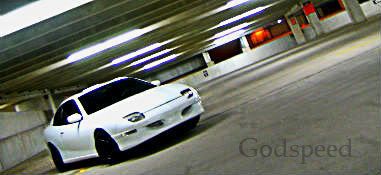But the Episode I-III kinda star Wars.....
Quote:
Asked on May 18, 1999 what my favorite movie was I, like many of my contemporaries, would have had an easy answer: Star Wars. Just one day later, with the release of Phantom Menace, that answer would change forever. It didn't make sense. Episode I, compared quantitatively to its predecessors and, according the huge amount of buzz surrounding it, must have been a much better movie. It had a bigger budget, benefited from modern technology, had really neat imaginary creatures and action-packed space battles. So what changed? Well, the environment in which the space fairy tale existed had, in 22 years, become much more sophisticated. Audiences wanted to experience something new in the same way the original film had been unprecedented for its time. Instead, George Lucas contented himself with producing a fancy new version of the same old schlock. That, and Anakin was really irritating.
With the $22,995 V6-equipped 2010 Chevy Camaro LS producing 304 HP, nearly as much as the V8-engined 2010 Ford Mustang GT, and the 426 HP 2010 Chevy Camaro SS starting at just $30,995, initial impressions of GM's new muscle car are extremely good. It's faster than its competitors and benefits from more svelte looks than the Dodge Challenger and less familiar styling than the 2010 Mustang. It's even more fuel efficient, with the V6 returning an impressive 17 city, 29 highway MPG-rating, while the V8 returns 16/25 MPG when equipped with the slightly higher-geared automatic transmission.
But this Camaro's also supposed to be about more than just numbers (click here for our 2010 Chevy Camaro Numbers Comparison) for one very important reason: it's based on the 2009 Pontiac G8 GXP. When we drove that car last November, we couldn't believe that a $40,000 Pontiac was like the new E39 M5, only better. That impression was the result of a driving experience that wasn't so much about the 415 HP Corvette-derived LS3 V8 as it was the car's subtle ability to read your mind, then react to what you wanted faster than we thought possible from a big sedan. In short, the G8 GXP is a handler before it's a muscle car and that's saying something for a vehicle that can hit 60 MPH in 4.7 seconds.
The opposite is true of this new Camaro. Based on an updated version of the G8's Zeta platform (here called Zeta II), the Camaro gets a 2.5" shorter wheelbase thanks to bringing the front wheels forward 6", then moving the A-pillar rearwards 3.5" to create a longer hood and new front suspension chosen to make that hood lower. Unlike the class-defining Mustang, suspension is also independent all the way around. The V6 starts with GM's FE2 coil-over suspension package, before moving up to standard FE3 on the V8-equipped SS. Wheels start out at a smaller-than-GXP 18x7.5" on the base LS, before moving up to a standard and massive 20x8" front, 20x9" rear on the SS. The G8 GXP's are 19x8". Most of the SS's standard equipment is available optionally on the V6 models, while the RS-package essentially looks like an optioned-up SS, but with a V6 under the hood.
Somehow, all those changes translate into an experience that's no less capable in fact the Camaro SS is 11-seconds faster around the famed Nurburgring than the G8 GXP but a lot less involving. Where the G8 GXP is all about including you in the driving, requiring and enabling you to aggressively wring the most out of its chassis, the Camaro SS doesn't seek to make the driver a crucial part of its equation. It makes the classic American muscle car mistake of confusing grip of which it has plenty with handling. Throw the two cars into a second or third gear (oh how we love big V8s) 90-degree bend and the Pontiac will encourage you to explore the limits of the rear tires adhesion using your right foot and communicative steering, the Chevy will push its vague front robbing you of speed. Sure, you can get on the throttle half way around and step the rear out, but not with the same degree of control the Pontiac delivers. The Camaro does bring one huge improvement over its platform-mate: there's virtually no body roll under any circumstances.
Well that and the incredibly successful styling. Chevy knows it looks good too, displaying a level of self-assuredness that would be absurd in any other segment. Here's a great example. Our co-driver asked a GM engineer whether the new Camaro increases "length or girth?" His straight-faced response? "It increases opportunity." Cocky, right? But they're right. Where the G8 looks like a rental car, the ZR1 looks like a bass boat enthusiast won the lottery and the CTS-V, even with its classy chrome mesh grille, looks like a tuner conversion, the Camaro strikes exactly the right balance between the mass appeal of its aggression and a more sophisticated retro futurism that successfully references the original while adapting new wholly new forms that are completely contemporary. Even though we've been staring at pictures of it for what seems like years, in person it's still surprising how good it looks.
If you've been following Jalopnik or even had a conversation with me at any point since last August, you're probably bored to death with hearing about how good GM's latest crop of performance cars are. The 2009 Corvette ZR1 is the best car I've ever driven, the 556 HP Cadillac CTS-V is an utterly awesome performance sedan and you've already been reading about the G8 GXP. So it comes as a surprise that Chevy's flag-waving everyman muscle car doesn't live up to those driving standards. Sure its stinking fast, but it doesn't make exploiting that performance rewarding in the way all the above did so well. It doesn't so much defy convention, as drive like you'd expect a Camaro would, a really good Camaro.
The other defining characteristic of the Camaro's driving experience is the interior. Hop in one and like a classic Camaro, the first impression is of claustrophobia. It feels like Chevy's designers have purposefully set out to make the interior, which is actually surprisingly large with adequate space for four adults, feel surprisingly small. Most of that comes from the slit-like windshield; its top sits at about the height of your forehead, something that will be familiar to Lotus Exige owners. Out through that narrow strip of glass, the hood bulge and fenders are prominently visible, accentuating the power under the hood. Unlike the Exige, there's almost 8.5" of vertical seat movement to accommodate a wide range of drivers. All of them will end up with their head in the exact same place: about a half inch from the ceiling as that's the only position that affords adequate forward visibility. Strangely, the wheel and instruments sit very high, never affording the wheel-in-lap arrangement that I prefer, even with the seat all the way up and the wheel all the way down.
That interior is also going to be a bugbear for the Camaro. While the overall shapes are appealing, the materials are mostly cheap plastic, even on the big knobs that you use to adjust the HVAC and stereo (Nav isn't an option). A huge swath of that cheap plastic runs from the steering wheel all the way to the right door. The standard-on-SS auxiliary gauges, mounted down low in front of the gear lever, are largely worthless on the move due to their positioning, but look really cool, providing a false sense of driver/machine integration that just isn't born out in the driving experience. Believe it or not, the 2010 Mustang with a few options is actually a nicer place to spend time.
On initial impressions and despite a spec sheet that strongly claims otherwise, I'd tip the hat in the Mustang's favor when it comes to driving enjoyment too. To create it, Ford engineers essentially took the old model and made it as good as they possibly could. The result is, for the first time, a Mustang that's as much about going around corners as it is about acceleration, which is good, because the Camaro SS leaves it for dead in a straight line. Despite the Mustang's live rear axle, which never really manifests any limitations on the road, the 'Stang is ligher on its feet than the Camaro and has considerably more steering feel. The Camaro's is dead on center, never really manages a huge amount of feel in general and is overly light. it's so light, that it's possible that the engineers that drove it around the Nurburgring did so one-handed.
The much-touted performance of the V6-equipped Camaro doesn't live up to its Mustang GT-killing hype. While GM has gone to great lengths to make it as visceral as possible the crisp exhaust note sounds almost as good as a 370Z its flat torque curve leads to a somewhat uneventful feeling of acceleration, especially out of faster corners where the Camaro's prodigious 3,780 Lb curb weight leaves you with foot flat on the floor, wanting for more. Nor does the V6 manifest a handling advantage over the V8, even when equipped with all the RS options. Its steering still lacks feel and it becomes harder to push the car around corners using the throttle.
GM's Hydra-Matic SL50 6-speed automatic gearbox does however do an excellent job of keeping the V6 on the boil, particularly in "sport" mode. Its one of the quickest-to-shift slushboxes we've experienced and never seems to find itself in the wrong gear. In fact its so good that it renders the steering wheel-mounted shift buttons largely irrelevant. The SL50 is clearly better than any of the Camaro's domestic rivals.
Look at the value-for-money and the performance numbers of the Camaro combined with its Dragon-tastic looks and you can't help but feel GM has a winner on its hands. It'll beat its competitors hands down, not only in a numbers-based pissing contest, but also in the public's imaginations: an advantage presented by its futuristic-yet-retro styling. It's exactly the car GM should be making, a car that will sell; it's just not the unprecedented new experience that we were hoping for, it's not a real driver's car. With the Camaro, GM has chosen to stick with the muscle car archetype rather than push the limits of what's possible, it's not likely to win many conquests from more adept sportscars like the 370Z, Audi TT and BMW 3-series as Chevy hopes it will. The result, like the new Star Wars films, is a product that will undoubtedly be a commercial success, just perhaps not a timeless classic like the original, a product that will blend in with, rather than stand out from, its rivals.


















cant say im a huge fan of the cluster arrangement..

It makes the classic American muscle car mistake of confusing grip of which it has plenty with handling.
Probably the single most apt description of why too many American cars aren't as much fun as Eurotrash ones despite posting impressive numbers on the trac and skidpad. A car that can go everywhere sideways in perfect control of itself is a lot more fun than a grippy car than can take a curve at 900mph.
i want one in black

Im a Xbox 360 fanboy...and damn proud of it!!
The interior looks fine to me, I have seen a couple at auto shows as well, and FOR its price I have little complaints. I see a job well done here.
 My Cav
My Cav
I give up...
i'm buying a VW those people love trees, so they should love eachother too... "Andy"
Truly a "modernization" on the '69 camero RS, even the interior. Definitely a fan!

Only thing I don't like about it is the fact that the other gauges aren't in the most desirable place if you're asking me.
Later
Redrider02
"big boom big boom"-Adam Savage. "quack damn you"-Jamie Hyneman "mythbusters"
GM has built so much anticipation for this car, you can kind of see it in stages:
Stage one:
GM: "GUISE WE'RE MAKIN' A NEW CAMARO!!! HERES A CONCEPT CAR!"
GUISE: "YEAH! NEW CAMARO! CAN I DRIVE IT?!"
GM: "NO."
Stage Two:
GM: "GUISE CHECK IT OUT, THIS IS OUR IDEA FOR SOME $#!^"
GUISE: "AWESOME $#!^, GM!"
Stage three:
GM: "GUISE WE'RE STILL MAKIN' A NEW CAMARO!!!"
GUISE: "STILL? JESUS!"
Stage Four:
GM: "WE HAVE A BUNCH CAMAROS TO SELL GUISE!"
GUISE: "YAY! I WANT ONE! SELL ME ONE IN BLACK!"
GM: "NOT YET!"
GUISE: "WTF?! SRSLY GM! I'M BUYIN' UR CARS NOW!"
GM: "TOO BAD! YOU WAIT FOR A BIT AND WE'LL LET YOU BUY ONE!"
I don't know why I thought of that, and it's probably a complete waste of a post, but I did. Now that you've read it, you cannot unread it.
2010 Honda Fit LX
I love the interior I think its awesome......thats a bad ass car!!!

My god the engine bays of new cars are ugly.

Camaro means invincible! will there be too much of them running around like Mustangs like common from now on???? damn it'll be too weird.
Looks great overall, with some lowering and rims. etc.. will be sick for sure. and love the interior!!!!
check out Camaro5.com too!
wow
http://www.camaro5.com/forums/showthread.php?t=16404
Edited 3 time(s). Last edited Monday, March 23, 2009 8:04 PM

I can't wait til the Consumers Report issue on this car comes out and makes snide/ snobbish comparisons to cars like porche/ nissan/ etc. I can see it now: PROS: Acceleration Cons: road noise, lack of "Obama approved" dash plate.
.
Poor Al Gore. Global warming completely debunked via the very Internet you invented. Oh, oh, the irony! -Jon Stewart
Wonderful job staying true to the exterior and interior versus what could've been. I enjoy.

and im sure the factory add on accesory intake will help clean up the bay some. cant wait for this. i like that last color too.

i honestly really like it. the only thing i see wrong with the car is the hood scoop on the SS... why make it so small? i'd rather have no scoop then have a small discontinuous one. just makes the front end look off and less aggressive IMO. go big or go home. either they make it functional or remove it...
dear god these things are HOT in black ...
Still iffy on the rear ...... its hard to explain, but its the way the wheels stick out to the side from a rear view ...... just looks weird
__________________________________________________________________
Where I work:
HP
What I take for Memory and Focus:
Focus Fast

I passed one Saturday morning here heading the opposite direction on the highway, I first thought it was a Challenger but when It went by I saw the ass end I said NO @!#$ to myself.. Looked nice.

I'll take mine in Silver....thanks

M62, 42's, ZZP 3", ZZP S3 H/E
214whp 190wtq
they gonna make em' t-topped?
 WiGM-Tuners member.
WiGM-Tuners member.
I will have one

1989 Turbo Trans Am #82, 2007 Cobalt SS G85
I like the look alot!
Only thing that kills it for me is on the auto, they could have come up with something a little nicer for the shifter console!

Lanman31337 -F = fatties = do not want. A little chunk in the junk is ok though.


































